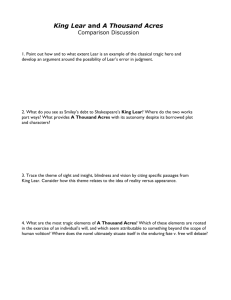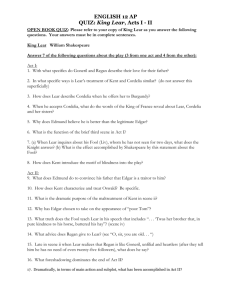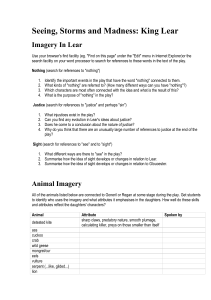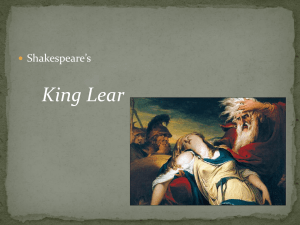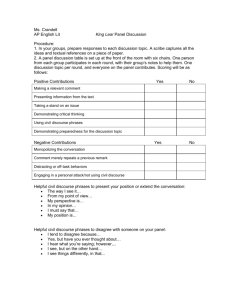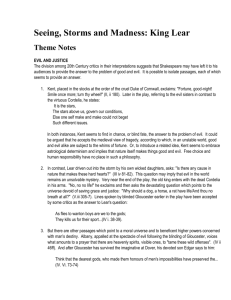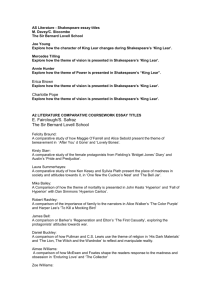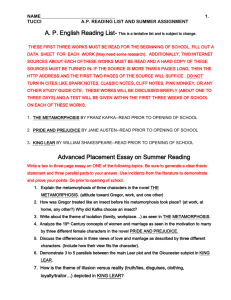Lear Centre.indd
advertisement
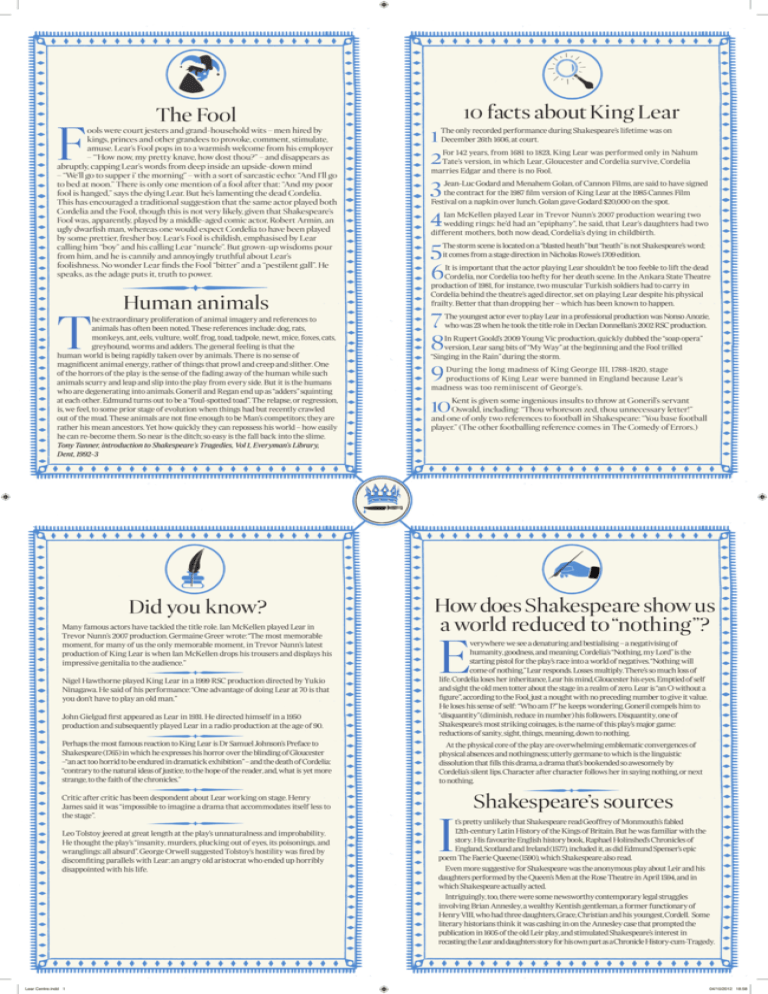
F The Fool ools were court jesters and grand-household wits – men hired by kings, princes and other grandees to provoke, comment, stimulate, amuse. Lear’s Fool pops in to a warmish welcome from his employer – “‘How now, my pretty knave, how dost thou?” – and disappears as abruptly, capping Lear’s words from deep inside an upside-down mind – “We’ll go to supper i’ the morning” – with a sort of sarcastic echo: “And I’ll go to bed at noon.” There is only one mention of a fool after that: “And my poor fool is hanged,” says the dying Lear. But he’s lamenting the dead Cordelia. This has encouraged a traditional suggestion that the same actor played both Cordelia and the Fool, though this is not very likely, given that Shakespeare’s Fool was, apparently, played by a middle-aged comic actor, Robert Armin, an ugly dwarfish man, whereas one would expect Cordelia to have been played by some prettier, fresher boy. Lear’s Fool is childish, emphasised by Lear calling him “boy” and his calling Lear “nuncle”. But grown-up wisdoms pour from him, and he is cannily and annoyingly truthful about Lear’s foolishness. No wonder Lear finds the Fool “bitter” and a “pestilent gall”. He speaks, as the adage puts it, truth to power. T Human animals he extraordinary proliferation of animal imagery and references to animals has often been noted. These references include: dog, rats, monkeys, ant, eels, vulture, wolf, frog, toad, tadpole, newt, mice, foxes, cats, greyhound, worms and adders. The general feeling is that the human world is being rapidly taken over by animals. There is no sense of magnificent animal energy, rather of things that prowl and creep and slither. One of the horrors of the play is the sense of the fading away of the human while such animals scurry and leap and slip into the play from every side. But it is the humans who are degenerating into animals. Goneril and Regan end up as “adders” squinting at each other. Edmund turns out to be a “foul-spotted toad”. The relapse, or regression, is, we feel, to some prior stage of evolution when things had but recently crawled out of the mud. These animals are not fine enough to be Man’s competitors; they are rather his mean ancestors. Yet how quickly they can repossess his world – how easily he can re-become them. So near is the ditch; so easy is the fall back into the slime. Tony Tanner, introduction to Shakespeare’s Tragedies, Vol 1, Everyman’s Library, Dent, 1992-3 Did you know? Many famous actors have tackled the title role. Ian McKellen played Lear in Trevor Nunn’s 2007 production. Germaine Greer wrote: “The most memorable moment, for many of us the only memorable moment, in Trevor Nunn’s latest production of King Lear is when Ian McKellen drops his trousers and displays his impressive genitalia to the audience.” Nigel Hawthorne played King Lear in a 1999 RSC production directed by Yukio Ninagawa. He said of his performance: “One advantage of doing Lear at 70 is that you don’t have to play an old man.” John Gielgud first appeared as Lear in 1931. He directed himself in a 1950 production and subsequently played Lear in a radio production at the age of 90. 10 facts about King Lear 1 2 3 The only recorded performance during Shakespeare’s lifetime was on December 26th 1606, at court. For 142 years, from 1681 to 1823, King Lear was performed only in Nahum Tate’s version, in which Lear, Gloucester and Cordelia survive, Cordelia marries Edgar and there is no Fool. Jean-Luc Godard and Menahem Golan, of Cannon Films, are said to have signed the contract for the 1987 film version of King Lear at the 1985 Cannes Film Festival on a napkin over lunch. Golan gave Godard $20,000 on the spot. 4 5 6 Ian McKellen played Lear in Trevor Nunn’s 2007 production wearing two wedding rings: he’d had an “epiphany”, he said, that Lear’s daughters had two different mothers, both now dead, Cordelia’s dying in childbirth. The storm scene is located on a “blasted heath” but “heath” is not Shakespeare’s word; it comes from a stage direction in Nicholas Rowe’s 1709 edition. It is important that the actor playing Lear shouldn’t be too feeble to lift the dead Cordelia, nor Cordelia too hefty for her death scene. In the Ankara State Theatre production of 1981, for instance, two muscular Turkish soldiers had to carry in Cordelia behind the theatre’s aged director, set on playing Lear despite his physical frailty. Better that than dropping her – which has been known to happen. 7 8 9 The youngest actor ever to play Lear in a professional production was Nonso Anozie, who was 23 when he took the title role in Declan Donnellan’s 2002 RSC production. In Rupert Goold’s 2009 Young Vic production, quickly dubbed the “soap opera” version, Lear sang bits of “My Way” at the beginning and the Fool trilled “Singing in the Rain” during the storm. During the long madness of King George III, 1788-1820, stage productions of King Lear were banned in England because Lear’s madness was too reminiscent of George’s. 10 Kent is given some ingenious insults to throw at Goneril’s servant Oswald, including: “Thou whoreson zed, thou unnecessary letter!” and one of only two references to football in Shakespeare: “You base football player.” (The other footballing reference comes in The Comedy of Errors.) How does Shakespeare show us a world reduced to “nothing ”? E verywhere we see a denaturing and bestialising – a negativising of humanity, goodness, and meaning. Cordelia’s “Nothing, my Lord” is the starting pistol for the play’s race into a world of negatives. “Nothing will come of nothing,” Lear responds. Losses multiply. There’s so much loss of life. Cordelia loses her inheritance, Lear his mind, Gloucester his eyes. Emptied of self and sight the old men totter about the stage in a realm of zero. Lear is “an O without a figure”, according to the Fool, just a nought with no preceding number to give it value. He loses his sense of self: “Who am I?” he keeps wondering. Goneril compels him to “disquantity” (diminish, reduce in number) his followers. Disquantity, one of Shakespeare’s most striking coinages, is the name of this play’s major game: reductions of sanity, sight, things, meaning, down to nothing. Perhaps the most famous reaction to King Lear is Dr Samuel Johnson’s Preface to Shakespeare (1765) in which he expresses his horror over the blinding of Gloucester –“an act too horrid to be endured in dramatick exhibition” – and the death of Cordelia: “contrary to the natural ideas of justice, to the hope of the reader, and, what is yet more strange, to the faith of the chronicles.” At the physical core of the play are overwhelming emblematic convergences of physical absences and nothingness; utterly germane to which is the linguistic dissolution that fills this drama, a drama that’s bookended so awesomely by Cordelia’s silent lips. Character after character follows her in saying nothing, or next to nothing. Critic after critic has been despondent about Lear working on stage. Henry James said it was “impossible to imagine a drama that accommodates itself less to the stage”. Shakespeare’s sources Leo Tolstoy jeered at great length at the play’s unnaturalness and improbability. He thought the play’s “insanity, murders, plucking out of eyes, its poisonings, and wranglings: all absurd”. George Orwell suggested Tolstoy’s hostility was fired by discomfiting parallels with Lear: an angry old aristocrat who ended up horribly disappointed with his life. Lear Centre.indd 1 I t’s pretty unlikely that Shakespeare read Geoffrey of Monmouth’s fabled 12th-century Latin History of the Kings of Britain. But he was familiar with the story. His favourite English history book, Raphael Holinshed’s Chronicles of England, Scotland and Ireland (1577), included it, as did Edmund Spenser’s epic poem The Faerie Queene (1590), which Shakespeare also read. Even more suggestive for Shakespeare was the anonymous play about Leir and his daughters performed by the Queen’s Men at the Rose Theatre in April 1594, and in which Shakespeare actually acted. Intriguingly, too, there were some newsworthy contemporary legal struggles involving Brian Annesley, a wealthy Kentish gentleman, a former functionary of Henry VIII, who had three daughters, Grace, Christian and his youngest, Cordell. Some literary historians think it was cashing in on the Annesley case that prompted the publication in 1605 of the old Leir play, and stimulated Shakespeare’s interest in recasting the Lear and daughters story for his own part as a Chronicle History-cum-Tragedy. 04/10/2012 18:58

